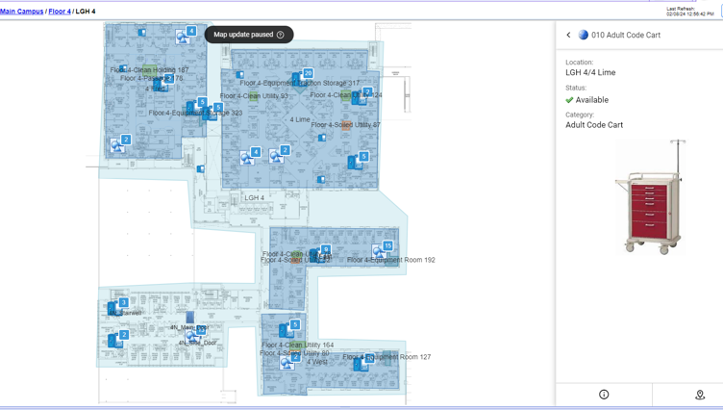While many hospitals and health systems currently use or have evaluated a Radio-Frequency Identification (RFID) solution for kit and tray management – few are aware of, or leveraging, Real Time Location Services (RTLS).
RTLS systems automatically track the location of tagged objects via fixed reference points, showing users where the tagged objects are in real-time. In a hospital setting, this can look like setting up fixed reference points in different rooms to create a map of the hospital that tracks where in the hospital tagged items (carts, trays, etc.) are located. Just like Google Maps shows you exactly where your car is on the map in real-time, RTLS does that for tagged items in your hospital.
On Thursday, February 29, 2024, Bluesight hosted a presentation where Layton Daniels, PharmD, MBA, Pharmacy Supervisor at Penn Medicine Lancaster General Hospital discussed how his hospital achieved positive outcomes by integrating Real Time Location Services (RTLS) and Radio-Frequency Identification (RFID). Below are the 3 outcomes Daniels achieved for his hospital by transforming its inventory management with RTLS and RFID.
Time Savings
In the fast-paced environment of a hospital pharmacy, time is a precious resource. Luckily, RTLS and RFID tracking technologies can help pharmacies save time in their inventory management workflows. That’s why we partnered with Penn Medicine Lancaster General to integrate RTLS and KitCheck; below are just some of the time saving results they saw as a result.
Prior to implementing their RTLS and RFID technology, pharmacy technicians at the hospital had to manually scan tray and cart locations in the correct sequence to accurately track the locations of trays and carts. Sometimes, technicians would even write down locations instead of scanning. Both of these processes left room for inevitable human error that resulted in missing carts and trays.
Following the implementation of RTLS and RFID technology, the hospital experienced a notable reduction in human error. With the automation of tracking processes, staff members are no longer burdened with manual scanning tasks. Instead, trays and carts equipped with trackers seamlessly update location data in real time, eliminating the need for time-consuming checks and ensuring accurate inventory management.
Moreover, the technology supports proactive inventory management and streamlined retrieval processes. Pharmacists and technicians can swiftly locate missing trays and kits using real-time mapping features, significantly reducing guesswork and optimizing workflow efficiency. Additionally, by utilizing reports to identify expiring items, pharmacies can more efficiently manage inventory turnover. See the facility map below as an example:

Resource Optimization and Cost-Savings
Between shortages and rising costs, it’s more important than ever to get the most out of the resources your institution already has. RTLS and RFID offer a pathway to significant cost savings and resource efficiency by revolutionizing how medications and supplies are managed.
The accuracy and data that RFID and RTLS technology provide can help hospitals reuse and redistribute items where they’re needed most. This process entails decommissioning items from one location and redistributing them to areas where emergency medications are frequently needed, such as procedure rooms and emergency departments. Collaborative efforts with other departments, like the IV room, further enhance resource optimization by identifying suitable items for reuse, thereby minimizing waste and maximizing efficiency.
By repurposing items from crash carts and kits, Penn Medicine Lancaster General Hospital saved over $50,000 in one year.
Improved Patient Safety
Patient safety is the number one priority of all hospitals and health systems. Making sure that the right medications are in the right place at the right time is a key component of ensuring that patients are safe.
By implementing RTLS and RFID technologies, hospital pharmacies can generate detailed reports on the whereabouts of critical items, aiding in the identification of discrepancies and issues like missing medications.
For example, by tagging rapid sequence intubation (RSI) kits and monitoring their locations in real time, hospital staff can efficiently manage inventory, prevent stockouts, and promptly locate essential equipment, mitigating potential patient safety risks. This transparency not only ensures the availability of necessary supplies when needed but also streamlines operational processes, contributing to overall efficiency and patient safety.
Want to Learn More About How You Can Drive Outcomes with RTLS and RFID? Check Out These Resources:
- KitCheck Mobile Pharmacy Cart Fact Sheet: For hospital pharmacies where space is at a premium — or where the workflow is decentralized — KitCheck offers a portable option to help streamline your medication restocking with 100% accuracy. With Medication Intelligence, take KitCheck benefits on wheels and save time restocking, eliminate stock outs and optimize medication spend on costly high turn OR medications. KitCheck gives pharmacies 100% visibility of OR medication usage and all this with no disruption in anesthesia workflow.
- Driving Operational Efficiency With RTLS & Mobile Cart Innovations: During this webinar recording, Product Manager TJ Bozada explores KitCheck’s latest advancements in RTLS to drive operational efficiency.



